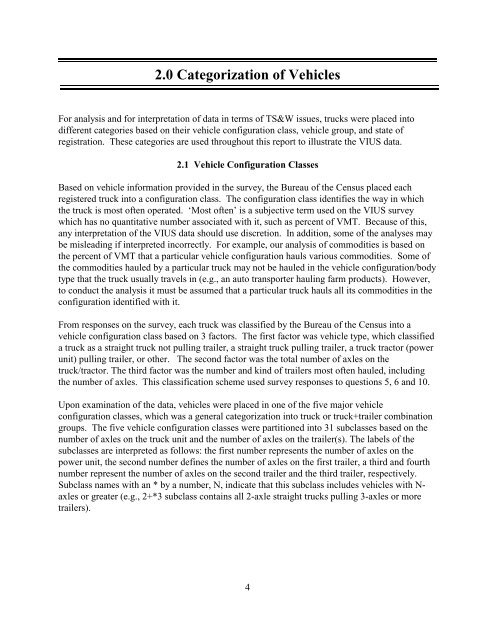Analysis of the Vehicle Inventory and Use Survey for Trucks ... - About
Analysis of the Vehicle Inventory and Use Survey for Trucks ... - About
Analysis of the Vehicle Inventory and Use Survey for Trucks ... - About
Create successful ePaper yourself
Turn your PDF publications into a flip-book with our unique Google optimized e-Paper software.
2.0 Categorization <strong>of</strong> <strong>Vehicle</strong>s<br />
For analysis <strong>and</strong> <strong>for</strong> interpretation <strong>of</strong> data in terms <strong>of</strong> TS&W issues, trucks were placed into<br />
different categories based on <strong>the</strong>ir vehicle configuration class, vehicle group, <strong>and</strong> state <strong>of</strong><br />
registration. These categories are used throughout this report to illustrate <strong>the</strong> VIUS data.<br />
2.1 <strong>Vehicle</strong> Configuration Classes<br />
Based on vehicle in<strong>for</strong>mation provided in <strong>the</strong> survey, <strong>the</strong> Bureau <strong>of</strong> <strong>the</strong> Census placed each<br />
registered truck into a configuration class. The configuration class identifies <strong>the</strong> way in which<br />
<strong>the</strong> truck is most <strong>of</strong>ten operated. ‘Most <strong>of</strong>ten’ is a subjective term used on <strong>the</strong> VIUS survey<br />
which has no quantitative number associated with it, such as percent <strong>of</strong> VMT. Because <strong>of</strong> this,<br />
any interpretation <strong>of</strong> <strong>the</strong> VIUS data should use discretion. In addition, some <strong>of</strong> <strong>the</strong> analyses may<br />
be misleading if interpreted incorrectly. For example, our analysis <strong>of</strong> commodities is based on<br />
<strong>the</strong> percent <strong>of</strong> VMT that a particular vehicle configuration hauls various commodities. Some <strong>of</strong><br />
<strong>the</strong> commodities hauled by a particular truck may not be hauled in <strong>the</strong> vehicle configuration/body<br />
type that <strong>the</strong> truck usually travels in (e.g., an auto transporter hauling farm products). However,<br />
to conduct <strong>the</strong> analysis it must be assumed that a particular truck hauls all its commodities in <strong>the</strong><br />
configuration identified with it.<br />
From responses on <strong>the</strong> survey, each truck was classified by <strong>the</strong> Bureau <strong>of</strong> <strong>the</strong> Census into a<br />
vehicle configuration class based on 3 factors. The first factor was vehicle type, which classified<br />
a truck as a straight truck not pulling trailer, a straight truck pulling trailer, a truck tractor (power<br />
unit) pulling trailer, or o<strong>the</strong>r. The second factor was <strong>the</strong> total number <strong>of</strong> axles on <strong>the</strong><br />
truck/tractor. The third factor was <strong>the</strong> number <strong>and</strong> kind <strong>of</strong> trailers most <strong>of</strong>ten hauled, including<br />
<strong>the</strong> number <strong>of</strong> axles. This classification scheme used survey responses to questions 5, 6 <strong>and</strong> 10.<br />
Upon examination <strong>of</strong> <strong>the</strong> data, vehicles were placed in one <strong>of</strong> <strong>the</strong> five major vehicle<br />
configuration classes, which was a general categorization into truck or truck+trailer combination<br />
groups. The five vehicle configuration classes were partitioned into 31 subclasses based on <strong>the</strong><br />
number <strong>of</strong> axles on <strong>the</strong> truck unit <strong>and</strong> <strong>the</strong> number <strong>of</strong> axles on <strong>the</strong> trailer(s). The labels <strong>of</strong> <strong>the</strong><br />
subclasses are interpreted as follows: <strong>the</strong> first number represents <strong>the</strong> number <strong>of</strong> axles on <strong>the</strong><br />
power unit, <strong>the</strong> second number defines <strong>the</strong> number <strong>of</strong> axles on <strong>the</strong> first trailer, a third <strong>and</strong> fourth<br />
number represent <strong>the</strong> number <strong>of</strong> axles on <strong>the</strong> second trailer <strong>and</strong> <strong>the</strong> third trailer, respectively.<br />
Subclass names with an * by a number, N, indicate that this subclass includes vehicles with Naxles<br />
or greater (e.g., 2+*3 subclass contains all 2-axle straight trucks pulling 3-axles or more<br />
trailers).<br />
4

















